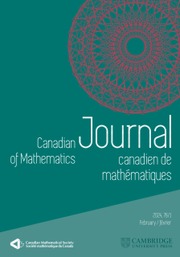No CrossRef data available.
Article contents
Biplanar Surfaces of Order Three
Published online by Cambridge University Press: 20 November 2018
Extract
Core share and HTML view are not available for this content. However, as you have access to this content, a full PDF is available via the ‘Save PDF’ action button.
0. Introduction. A surface of order three, F, in the real projective threespace P 3 is met by every line, not in F, in at most three points. F is biplanar if it contains exactly one non-differentiable point v and the set of tangents of F at v is the union of two distinct planes, say τ 1 and τ 2. In the present paper, we classify and describe those biplanar F which contain the line τ 1 ∩ τ 2.
We describe a surface by determining the tangent plane sections of the surface at the differentiable points. This approach was introduced in [1] and it is based upon A. Marchaud's definition of “surfaces of order three” in [4].
Information
- Type
- Research Article
- Information
- Copyright
- Copyright © Canadian Mathematical Society 1979
References
1.
Bisztriczky, T., Surfaces of order three with a peak, I. J. of Geometry, 11/1 (1978), 55–83.Google Scholar
4.
Marchaud, A., Sur les surfaces du troisième ordre de la Géométrie finie, J. Math. Pur. Appl. 18 (1939), 323–362.Google Scholar
5.
Marchaud, A., Sur les propriétés différentielles du premier ordre des surfaces simples de Jordan et quelques applications, Ann. Ec. Norm. Sup. 63 (1947), 81–108.Google Scholar
6.
Scherk, P., tîber differenzierbare kurven und bôgen I. zum begriff der charakteristik, Casopis Pëst. Mat. 66 (1937), 165–171.Google Scholar

